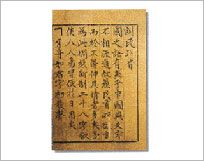 | |
| |
King Sejong, the 4th king of the Joseon Dynasty, concerned that the majority of common people could not learn the written Chinese then in use in Korea because of its structural difference from Korean, created the Korean alphabet, which he called Hunmin Jeongeum, (Proper Sounds to Instruct the People). The task was completed in the 25th year of his reign, 1443. Three years later, at the king's command, the alphabet was promulgated by the Jiphyeonjeon, or "Hall of the Worthy," in a 33-page book in Chinese, Hunmin Jeongeum Haeryebon, the Explanatory Edition of the Proper Sounds to Instruct the People.
This work consists of two parts. The first part, written by King Sejong himself, contains a preface setting at his purpose in creating the new alphabet followed by the main text, which explains each of the 28 letters, with examples of consonant-vowel combinations. The second part, written by Jeong In-ji and seven other scholars of Jiphyeonjeon, consists of six chapters: 'An Explanation of the Design of the Letters,' which expounds the phonetic and philosophical principles by which the new letters were made, 'An Explanation of the Initials,' which presents the 17 consonants which appear in syllable-initial position, 'An Explanation of the Medials,' which presents the 11 vowels, 'An Explanation of the Finals,' which presents the consonants appearing in syllable-final position, 'An Explanation of the Combining of the Letters,' which demonstrates how the initials, medials, and finals are assembled to form syllables, and 'Examples of the Use of the Letters,' which shows words written with the new letters. These are followed by a postface by Jeong In-ji.
Hangeul, as this alphabet has come to be known, is unique among the world's writing systems in having been created at a specifiable time by identifiable people, without any direct influence from already existing writing systems, to become a national written language. Moreover, no other writing system has ever been promulgated in an explanatory volume. Hangeul originally had 28 letters, but four letters have dropped out of use, leaving 24 letters, 14 consonants and 10 vowels. Hunmin Jeongeum was designated as National Treasure No. 70 to ensure its preservation and was registered in UNESCO's Memory of the World in October 1997.
Source : visitkorea.or.kr
This work consists of two parts. The first part, written by King Sejong himself, contains a preface setting at his purpose in creating the new alphabet followed by the main text, which explains each of the 28 letters, with examples of consonant-vowel combinations. The second part, written by Jeong In-ji and seven other scholars of Jiphyeonjeon, consists of six chapters: 'An Explanation of the Design of the Letters,' which expounds the phonetic and philosophical principles by which the new letters were made, 'An Explanation of the Initials,' which presents the 17 consonants which appear in syllable-initial position, 'An Explanation of the Medials,' which presents the 11 vowels, 'An Explanation of the Finals,' which presents the consonants appearing in syllable-final position, 'An Explanation of the Combining of the Letters,' which demonstrates how the initials, medials, and finals are assembled to form syllables, and 'Examples of the Use of the Letters,' which shows words written with the new letters. These are followed by a postface by Jeong In-ji.
Hangeul, as this alphabet has come to be known, is unique among the world's writing systems in having been created at a specifiable time by identifiable people, without any direct influence from already existing writing systems, to become a national written language. Moreover, no other writing system has ever been promulgated in an explanatory volume. Hangeul originally had 28 letters, but four letters have dropped out of use, leaving 24 letters, 14 consonants and 10 vowels. Hunmin Jeongeum was designated as National Treasure No. 70 to ensure its preservation and was registered in UNESCO's Memory of the World in October 1997.
Source : visitkorea.or.kr


No comments:
Post a Comment